#sutviprra
Text

I summon the monsterfuckers, monsterlovers and monsters of the world to rate my creation. Here are four so far established.

Sigitiru, once inspired by Time Lords of Doctor Who series, but now mangled and smashed around as was my will. All of them are in some way ancient, cryptic and wise, as much as they are primal, modern and hopelessly maladapted for normal interaction. Any individual will be incorporated with some kind of technology, have some sort of weird genetic trade or cosmetic modification. Note, if you wish to court them - they are on average more on graysexual side, as after the deed their bodies are rocked by hormonal surges, that could be lethal. Communication and high trust is key here.

Sutviprra worldbuilding project is currently ongoing and I don’t want to be prescriptive. From what I’m getting now, they are on average more communal, short tempered when under stress and very interested in shifted states of conscience. Their romantic and sensual feelings are associated with intoxication and hormonal changes. Their spermatophore’s edible part is psychoactive for them, adding to their experience of shift of perception while in love.

Strikell come from the same planet as Sutviprra, they manage to get distinct. They have more familiar to people gender dimorphism, with males more colorful, bigger and territorial. Their “hands” - structure inherited from wings, freakishly flexible and scarily strong. This is part of their climbing and running adaptation, in tow with long legs and great stamina.

Zxer name is Zurrow, I wanted to make a joke about how big they get. Their size and appearance, their thunderous calls and scarily long memory, invoke images of elephants and spiders. And, yeah, if you love and know those animals, that good enough. They know about their visage, and play into it when under stress. While friendly, they are incomparable in their ability to be gentle and care. They have inbuilt brushes to groom hair, their forearms have claws, but also cushions to gently pluck.
Let me know what you think
#sutviprra#art#speculative biology#worldbuilding#spec bio#alien design#exobiology#spec evo#speculative evolution#digital art#monster dating#monster lover#monster romance#monsterfucker#monster#monster design#strikell#schotto#alien fucker#alien lover#alien species
32 notes
·
View notes
Text

6 Sutviprra emotions as a teaser for their colang and communication methods
48 notes
·
View notes
Text

It was such an honor to meet Щem

what is this picture about? what’s going on? why a warlus? does Mitski like them?
#sutviprra#art#speculative biology#worldbuilding#spec bio#alien design#exobiology#spec evo#speculative evolution#digital art#mitski#walrus#creature#poses to draw#draw your oc like this
19 notes
·
View notes
Text

Hurrydly jumping on the Moo Deng train, anything about her is true about Sutviprra, pigmy hippos are a pretty good reference for them




#sutviprra#art#worldbuilding#speculative biology#alien design#spec bio#exobiology#spec evo#speculative evolution#digital art#moo deng#pigmy hippo#thai zoo
16 notes
·
View notes
Text

#sutviprra#art#speculative biology#worldbuilding#alien design#exobiology#spec bio#spec evo#speculative evolution#oc meme
71 notes
·
View notes
Text
Sutviprra Update and Addendum
I have reconsidered some parameters, and some were present in an early version but not stated clearly enough.
First of all - previous versions of trunks would need a lot of resources to sustain and no evolutionary pressure would make such a hypertrophy. I still don’t completely delete such length - if the allele that made current trunks happens, Sutviprra will get abnormally long trunks, but do they stay alive and pass them down - question to their environment. Norm, from now on is such. Sutviprra ancestors lived on the jungle river shores, and lengthened lips allowed them to forage from the bottom, catch fish and, potentially, stand up and reach a low branch with a fruit. As the jungles receded, they also started scavenging, and this is where tool use and sapience development really started.

Tentacle apparatus is not as massive, but still, this adaptation disrupts previous muscle connections. Sutviprra belong to phylum Tetragnata - “four jawed”. In their class, jaws are capable of both vertical and horizontal motion and upper jaws serve radula-like grate function, grinding down food. In Sutviprra, trunks took up so much muscle attachment, movement of radula became restricted. At first, lower jaws complemented the function, developing an incisor-like section for cutting the food items and improving a tongue to move the food under the radula. With diversification of the diet, chewing apparatus alone stopped being sufficient, but this is what incited a pressure to develop pre-ingestion processing, so tool use and fire.
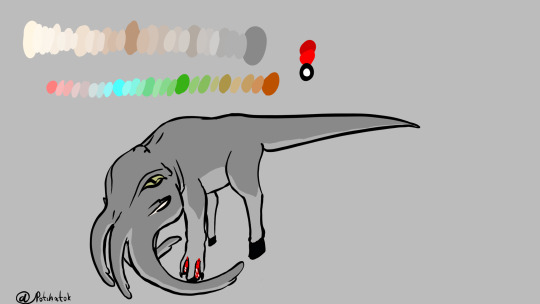
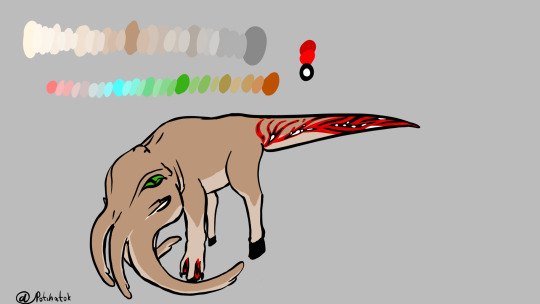
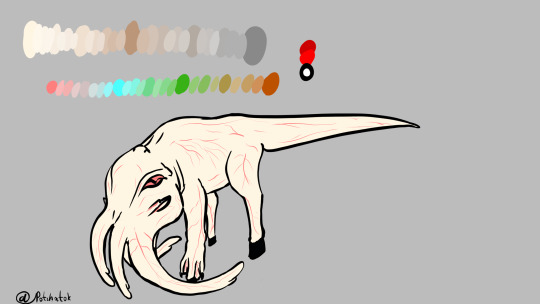

Their class, Cryptotheria, arose in a frigid polar environment, so at first all their adaptations all work to preserve energy and heat. Previously continuously hermaphroditic, In this condition producing redundant organs is not worth the energy, and, given the population density, sequential hermaphroditism becomes a norm. Most of such creatures are born male and depending on their condition become female later in life. As the conditions change, the race for populating new niches has begun, while conditions stayed rather rough - boreal forests are the warmest regions available. Many creatures evolve some sort of childcare, as this improves their chances. Proximapters already had ovoviviparity nesting and nest guarding behaviors, while Cryptotheria diversified with different strategies. Marsupacrescentia just rely on long gestation, when the embryo can be atrophied or put in a hibernation depending on resources of availability, while Mellacrescensia adopt altricial young, but their scent glands mutate to secret a gel, that helps the young to develop to a proper degree. This allows them to fill in niches of smaller animals, both sanitary and migratory. One of such offshutes, a medium-sized omnivore, reaches Oujsoerian jungles, diversifying there into the Tropicasussa. Such creatures lose their fur, have long gestation periods and a high intelligence. Living on the river coasts, Tropicasussa encounter pressures that kick them into the Sutviprra path. Energy efficiently of Cryptotheria allows them to achieve such brain functions, Mellacrescensia’s high requirement for parental care establishes fundamentals for learning from the adults, Tropicasussa’s opportunism allows for a wide variety of energy sources and a big range of behaviors - smartness. Of course, there were different species of sophont Tropicasussa, and Sutviprra represent hybridisation of some of those, that ended up colonizing the continent.

#sutviprra#art#speculative biology#worldbuilding#spec bio#alien design#exobiology#spec evo#speculative evolution#digital art
13 notes
·
View notes
Text
Almost two thousand years have passed since the plague that decimated the populations of Sutviprra on the shores of the three lakes. The illness is a fact of life, and most Sutviprra and pet kúarruzèam groups - here called “nén” - survive by steering clear of the outsiders and relying on immunity. Their lifestyle is archaic, akin to the one that of their ancestor’s experience on the modern day Oujsooer desert. but now they have an ally - kúarruzèam alert them of dangers and potential camp sites, working somewhat like a service animal for generationally anxious sophonts. Relief from the worries frees up mental resources and allows sárrárr to observe, learn and interpret the world around them.

Rich mythos springs up from the observation of the nature around them. Lakes are important for life in a desert, so water is granted a fundamental role as the all mother and the patron of all life - náuynúvu, which created first community with the sun - ry'nzàum - a harsh teacher of life, moon - kyzerrèyn sóaevyàzayn, who was born male but after the creation had undergone protandry, a group of titans - ry'nóàm rrèaem - their image interpreted from the suspicious chaotic line of stone - glacial formation, the face bearer and a beauty patron ry'n sárrárrán and uninterested in the pleasures creator of mountains máarráavÿm ry'n vuzy'nóàm. Their polycule produced all known worlds, trees, animals and Sutviprra, be it because of phantasmagorical birth or miraculous creation. As the living walk this earth, so do the dead - there are claims of nèn sárráàm - army of the dead, composed of ancestors, as wise and as strong as they were in life. Rraeru, unfortunately, cannot enjoy a big company in life, so there is a promise of supreme union in death. Destitution and loneliness plays a big role in the culture, though one might theorize, how sárrárr is never alone. They see figures in the cracks of stone and eye-like structures on the bark of the coastal trees. Mòmárrárr jozén keep watch on their territory, will keep safe if pleased and will bring pestilence if angered. Most common dangerous critter for Sutviprra - hematophagic sóazèm - tic-like radiosimmetrical bug, dwelling on the shore of rivers and giving another test for Sutviprra’s immune system and hygiene tradition. So far, sárrárr use mud to protect their skin, hoping to close off the skin or deprive a sóazèm of air. Hygiene procedures are a luxury, affordable only on the settlements, under the watch of záyn zàurujÿm - the first evening star visible in the night sky. Her brother tùm ry'n ròm is not as reliable - this star travels across the sky, moving under the horizon and behind sóatevyázayn around the year.
Their spiritual belief is a reflection of their social structure. The nén is structured with an elder matriarch - náuyn - on the top, who makes the main decision after a discussion with other older members of the group - ty'nmezén, while parent age members look out both for the elderly and for the children. Both polyamory and asexuality are acceptable, though polyamory is permissible only with people who are higher in hierarchy and male asexuals are pressured to transition. If Sutviprra has a family member in the ty'nmezén, they are of the néunárr, they are considered more reliable and allowed to start polycules. Their children are brought up communaly, but their lineage is important for their status and who takes place in the ty’nmezén when the previous elder passes. There are also options to leave for another nén, but that makes you tùmròm and no longer welcome in this particular tribe. From there, splinterers can either start their own nén or join another one - they become sárrèmárr, treated with suspicion first until earn other’s trust, get invited into one of the polycules or start a family with another of your rank, in which case your lineage enters the institutions two generation later.

In this way Rraeru disperse over the southern shore of the lakes, split into Raeru and Ráàru. Raeru dwell on the Vuzy’fa shore, have a sporadic contact with Unu and even travel by boat, to the Jotèmeuzé, populations of which themself later drift from the original. Ráàru have a geographical access to the Jozén, but they are generally kept out of it by the indigenous sutviprra.
#sutviprra#art#speculative biology#worldbuilding#spec bio#alien design#exobiology#spec evo#speculative evolution#digital art
12 notes
·
View notes
Text
Sutviprra keep on! In the jungles of Oujsoer, Ēwar’ sutviprra attracted the most attention. Though not necessarily on the top - among various predators, adapted to hunt creatures just like them, like Furazauiwod fallstalker and tropical short winged Oushikawod and Werkushinouakh raptors, or crocodile-like Ohghour’nikhnukhsurkiakh, waiting to snatch anything that comes for water, among various hazards, like poisonous or aggressive nukhnoonyynaazwas, wewariy and sur’kykakhsoowghour’, as well as competition from their close relatives - aersyrwasruz and werwaruzsywaseewar’ tropicasussas, they have to manage their resources and territory even in such abundant biome. Some keep close rivers, within engineered environments, making dams or supporting specific trees, securing a spot where they know they can get food in the specific season. While “ruling cast” of the north are organizers kaar’, in the dense jungle with complex ecology, the leading group is eeniowas - those, who’s trade is in nature, in learning variation in animals, fungi and plants and their utility. There is no outright religion, reverence is given to the elderly, to those who pass on or to the knowledgeable, there are various myth continuities with varying interaction with reality. The belief complex of Okhdeur’sur’fu’r is one taken as thruth, this is the one taught by the Eeniowas matrons - in their theory of the natural environment and its management, various superstitions and mysticism is mixed in. They believe in the tie between their families and their burial sights - nisniowekshisoow, where the dead serve as the fuel for a great garden, - and the oldest trees in the middle - Wekshinieinis, in various assumptions about animals and in the existence of monsters as if they are real. There is also a mythos, known to be an invention - the setting for children’s fairy tales, with repeating characters and tropes.
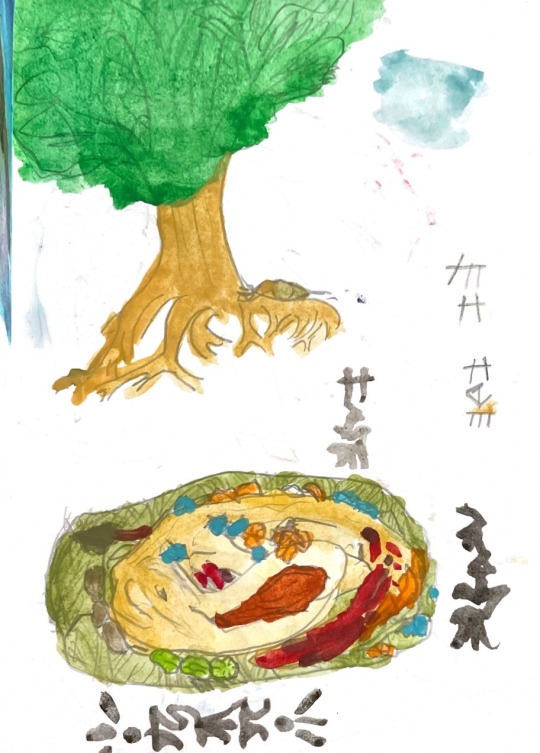
But in the jungles there is plenty of space and it’s easy to miss someone in the dense vegetation. Parallel to Ēwar’, many singular independent tribes forage of the same land. When efforts of Kaikaisurr’ were centralized, such tribes dwindled in population and lost their territory, but with fracturing of Ēwar’ they managed to restructure themself into a new culture - Ledealada. They all share the experience of being pressured out of their normal dwellings and having to explore unknown regions. Such prosecution sparked, at first, rapid development of food recourcing and weaponary, and than an allience of several tribes. This organization managed to push back against against the Ēwar’, carving out the territory in the jungle. The Ledealada people returned to their land victorious.
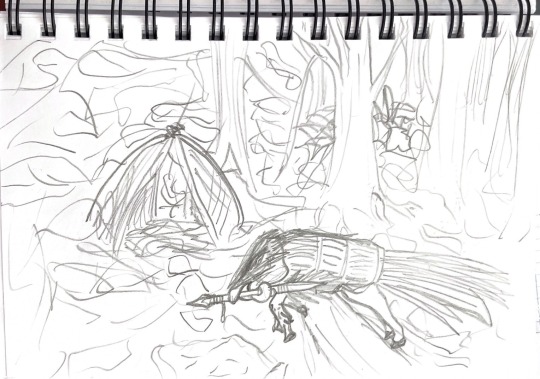
#sutviprra#art#speculative biology#worldbuilding#spec bio#alien design#exobiology#spec evo#speculative evolution#digital art#nonhuman
7 notes
·
View notes
Text
On the Western peninsula Natam, the arrival of Lan Mñats resulted in a shift. By itself Lun Mñats are not very militaristic, but their mounts require grass fields to eat, making them compete for the land with indigenous Sùtòtòm sutviprra for habitat. Also, Lan Mñats tradition of covering themself, hiding all the skin, immediately alienates other non-unzu cultures. The riders arrive either seasonally or stay in one territory for one year, which puts the local ecology in a straign. To protect their animals, Sutviprra kill local predators, while uncontrolled populations of domesticated Mñats eat away at local vegetation. The soil degradation start to creep in, as this area relatively recently was a desert, and the herd animal activity resurfaces all the sand from that time. Such changes prompts Lan Mnats to move further into Dumkatsdoñ, and the Sùtòtòm either militarizing against the Lun Mnats or migrating across the Kùlónsárrèm onto the new territories - islands Josénfústòkn and Jorrfústòkn.

As you remember, Unzu are uniquely adapted to live in mountains, especially with domesticated mñats. Concurrently with colonization of Dumkatsdoñ, Lun Mñats arrived and settled on the Nыmamoz Sanan, known to indigenous people as Vunonán. Several generations of skirmishes followed, and while Rrék sutviprra have better understanding of the land and nature, Lan Mñats have the ability to swiftly retreat and regroup on the highlands - areas inaccessible for Rrék. Such advantage, unfortunately, led to the extermination of Vunonán Rrék on the mainland. While Lan Mñats are unparalleled on land, they lack any seafaring knowledge, allowing Rrék to flee on the islands. There, they would have to compete or ally with local sárrárr. Going from enclosed mountains to populated shorelines and seas has a perk of capability of cultural exchange. Further along the Kùón, there are more islands with more cultures. Kosán island is one of the bigger landmasses in the inner seas, being guarded by the Dotòm who understand the significance of their territory. Sutviprra of Kosán have loose connection with Jokosárrádi archipelago, which link up with Fúsòm, Fútemesen, Fújosén, Jozètín and Fújosárr. Fújosén poses as a rival to Kosán, being an island with the same potential.


Lan Mñats up north introduced an unstable population of grazers to Joénky’n, causing an ecological disaster far beyond the scale of a simple göts. Without usual root systems, the soil is washed into the rivers by the rains. Rivers carry the mud down into the sea of Kùlónsárrèm, causing frequent algi blooms. Environment becomes uninhabitable for sealife, depriving islander sárrárr of much food they relied on. Sutviprra have to pay special attention to their environments to survive. The main architect of the Fusnmatàmian ecology is a séón tree. During harsh temperatures of a pre-blooming season, it generates oil around itself, making the area a genuine fire hazard. Bushfires both get rid of séón’s competition and prepare the soil for the next generation. The tree itself has several parasites and symbionts, who benefit from the clearing of territory. Many other plants don’t actively cause fires, but have adaptations to survive the fire. Séón trees have made their water storage double as a cooling , allowing them to survive the Torrùteúán and Sólúmèm have intricate root systems, allowing them to regenerate their leaves and stems after the fire season has passed. After the blooming, plants encounter a different issue - seedfeeding tetrapters and intetrognatas might destroy their prospects. Fèàsèmesón have their seeds inclosed in tough skin, while sàtùmosárr tangles onto itself to make it’s seeds inaccacible. In both cases, plants rely on herbivours to eat the fruits and swallow the seeds whole - that way they will be desperced wherever this creature goes in the past two weeks. Sárrárr also turn to this mode of feeding, along with sparse hunts and fungoid foraging. Animals on the island are familiar, but smaller than mainland speciments, provoking fears of hunger. To survive, Sudm have to manage their foodsources, rather than forage.
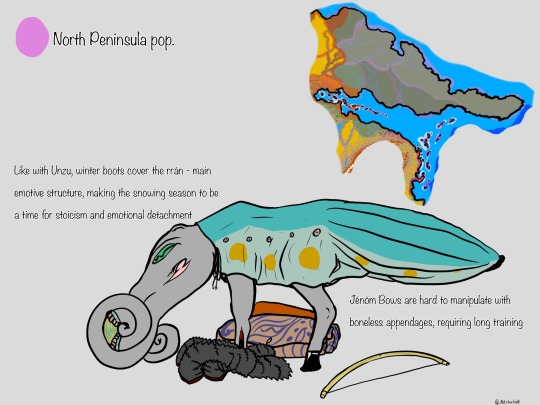

#sutviprra#art#speculative biology#worldbuilding#spec bio#alien design#exobiology#spec evo#speculative evolution#digital art
9 notes
·
View notes
Text
Plants of Natàm






#sutviprra#art#speculative biology#worldbuilding#spec bio#alien design#exobiology#spec evo#speculative evolution
9 notes
·
View notes
Text
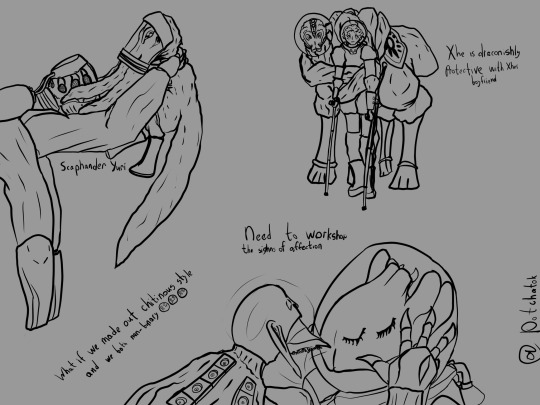
Space suit Romance 💛🌌
#art#sutviprra#speculative biology#spec bio#alien design#exobiology#spec evo#digital art#romance#monster#scifi#strikell#schotto
9 notes
·
View notes
Text
Animation of a couple of SodGol animals I’ve done for uni
#sutviprra#art#worldbuilding#speculative biology#spec bio#alien design#exobiology#spec evo#speculative evolution#digital art#animation
10 notes
·
View notes
Text
The entire planet maptoglobe render
#sutviprra#art#worldbuilding#speculative biology#spec bio#alien design#exobiology#spec evo#speculative evolution
9 notes
·
View notes
Text
Sutviprra seem to be going at a steady rate, but for you and me to see the full picture, we must travel to the south, across the equator, to another continent. It has different plants and animals, though some are recognized. 22 million years ago, a flock of peculiar creatures started entering and exploring new arid climate zone. These are Australisapters, descendants of flyers who abandoned the skyes and settled this land. They still have the wings, though shortened. This particular species travels in groups - they are generalist foragers, who mostly dig in the underbrush. They designate a sentinel, who for now abandones food but looks out for predators. In cases of emergency, indicated by vocalizations, they must either escape to the treetops or group up and puff up, intimidating the intruder into walking away. As, with millions of passing generations, they adapt for their environment, short wings transform into heat-regulating structures, which incidentally have some prehensile capability.

Descendants of these creatures would colonize the steppes, deserts and jungles, and as the continent moves, mountain ranges rise, also available to them. Rocky environments provide protection from most predators, but also by itself are very tricky, difficult to forage and navigate, requiring complex resource management, planning and cooperation from the ancestors of Strikell. Difficult environment and frequent volcanic winters cultivate the spesies with a great sophont potential. Above all else, they are adapted to think - jaws and scent receptors shrunk as a result of cephalization, the neck is no longer capable of perpetually supporting the head, and the brain eats up much of a creature's energy. They also have specific adaptations for communication. From the ancestors they still preserve a very articulated vocalization apparatus, capable of producing almost any sound on a medium volume, as well as creating far traveling songs for long range communication, though with less variety. Also, what once were konards on a flying tetraptera, now became flags for mood communication. With that, they also developed cacadu like crests to assist in emotional expression.

Their second adaptation is climbing - their legs are proportionately long, with paws having retractable claws, capable of getting a grip on any vertical surface. With that, they also have their “hands” - once those were wings, then heatshedding structure. But it’s skeletal structure allows them to rotate in many directions, and the “fingers” at the ends are very dexterous. So, these hands became adapted to assist in climbing and tool use. In the begining, their routine is travaling from high elevation to the jungles below, aquering food and traveling back to escape predators. For the most part, mountains are a good shelter - most megafauna carnivores could not enter the mountains. Hazards to look out for are either predator birds, from which hiding is the option to escape and cougar-like raptors, against which mobbing, shouting and throwing stones mostly works. Mountains by itself are a dull environment without much to eat, so during their expedition they not only eat, but collect fruits, plants and small prey for later, keeping it in volven baskets. Baskets are also helpful with egg storage - while Strikell are ovoviviparous, in a healthy state laying the egg just before the hatching, but even this could mean from several hours to days of caring for an egg, not to mention any various hormonal missfireings or stress responses, which can cause an early laying. Coming of global cooling made jungle resources more scarce, starting up fierce interspecies competition. Bigger groups chase off every other family, depriving them of food. The exiled individuals have to find another way to forage. Restricted to mountains, with desert on the one side of the mountains and aggressive adversary to the other side, only those, who can innovate survive. Using the mountain range as a cover and as a railway, shelter from competition and desert heat, several sophont species colonized southern, more temperate territories, desert rivers, and even return to jungles and savannas, once they discover fire.







#art#speculative biology#worldbuilding#spec bio#alien design#exobiology#spec evo#speculative evolution#digital art#sutviprra#strikell
6 notes
·
View notes
Text

Close, continuous contact between Sutviprra and Kurrezem without any understanding of illness transmission and sanitary practices leads to plague, which ravages populations around the lakes. Entire tribes are wiped out, leaving hauntingly deserted camps. Sometimes, only individuals survive, but those either die on their own or find a new clan, but spread the pathogen onto them. Previous sentence applies to both Sutviprra and to Kusùm, with crows being able transmit it over a great distance. This crisis provoked a mass migration, Some moved inland, mixing with previously uncontacted tribes, some braved the mountains, and some dared to go out onto the open sea. Sutviprra of Vunónàún encounter the limit of their anatomy - like with early Unzu, they cannot go through rocky terrain without damage to their hooves. However, they don’t have as good of a culture of leatherwork, so these families develop the philosophy of daily routine and rest. Yes, they don’t travel a great distance, but they preserve their health, so in the end such culture manages to prevail in the isolated mountain valleys. In time, another Sutviprra arrived in the region. Descending from Lun Mauñuts all the way across the continent, Sutviprra riding on the backs of the domesticated Arctotheria. That arrival provoked upheaval in the Rrék, long struggle for domination which ended in some sort of equilibrium - generally rocky highlands are taken by Lan Mñats, while lowlands are more of a Rrék territory. These wars don’t in any way limit trade in exchange - even in lowlands, Arctotheria are commonplace.
Sea-ferrying tribes at first use the vessels they used for traversing lakes, but with time get more specialized for far greater distances and more dramatic weather. They reach the island chain near the shores of Vunónàún and the opposite shore of the Kùrón, where the settlers split into people of Fúsy’n Jotémeruk and Jorrón. As Sutviprra, Kuzerrem did survive the plague and followed them, whenever they went.
#sutviprra#art#speculative biology#worldbuilding#spec bio#alien design#spec evo#exobiology#digital art#speculative evolution
9 notes
·
View notes
Text

Early Sutviprra getting dressed
#digital art#art#creative writing#speculative biology#exobiology#spec bio#original species#spec evo#sophont#creature#culture#alien design#sutviprra
31 notes
·
View notes